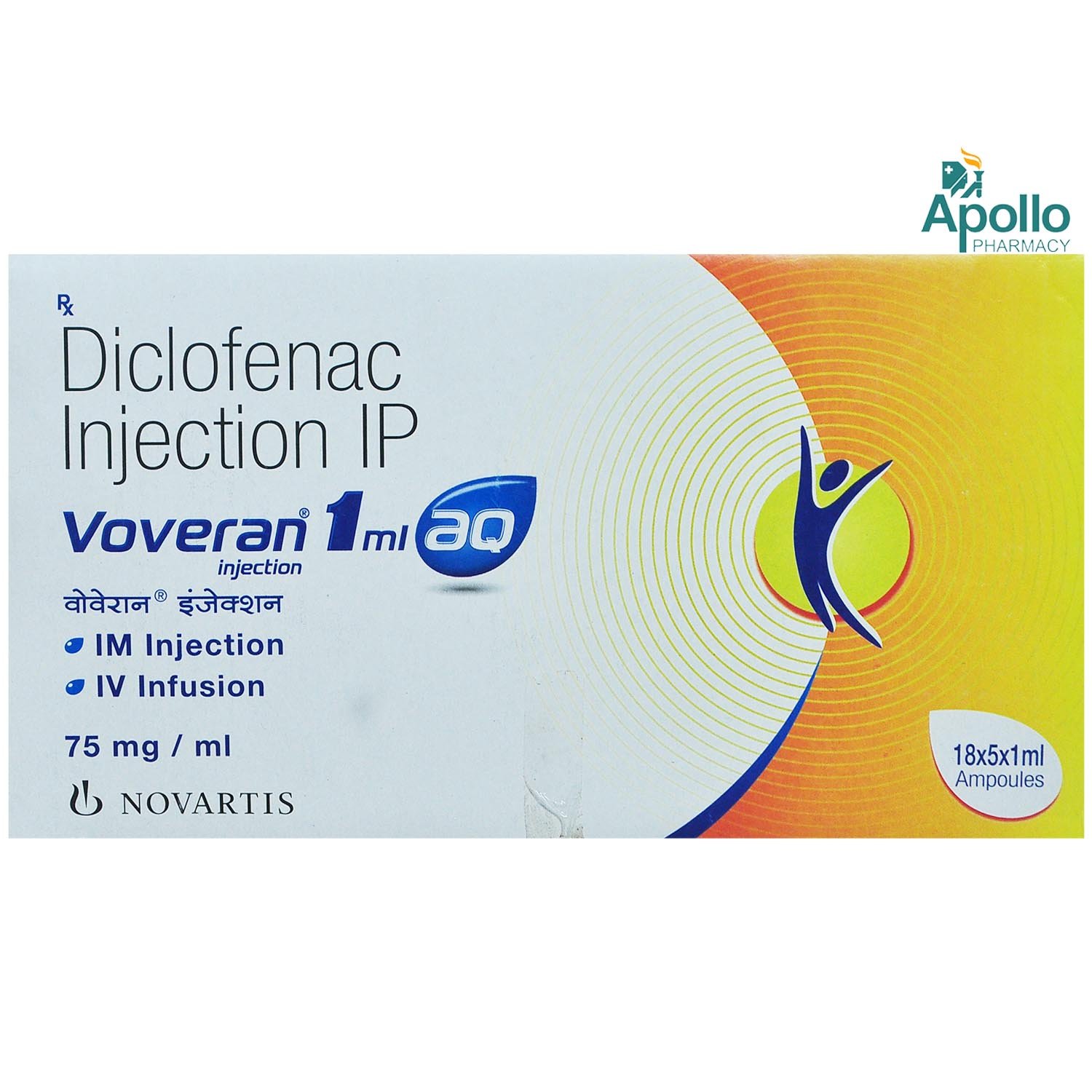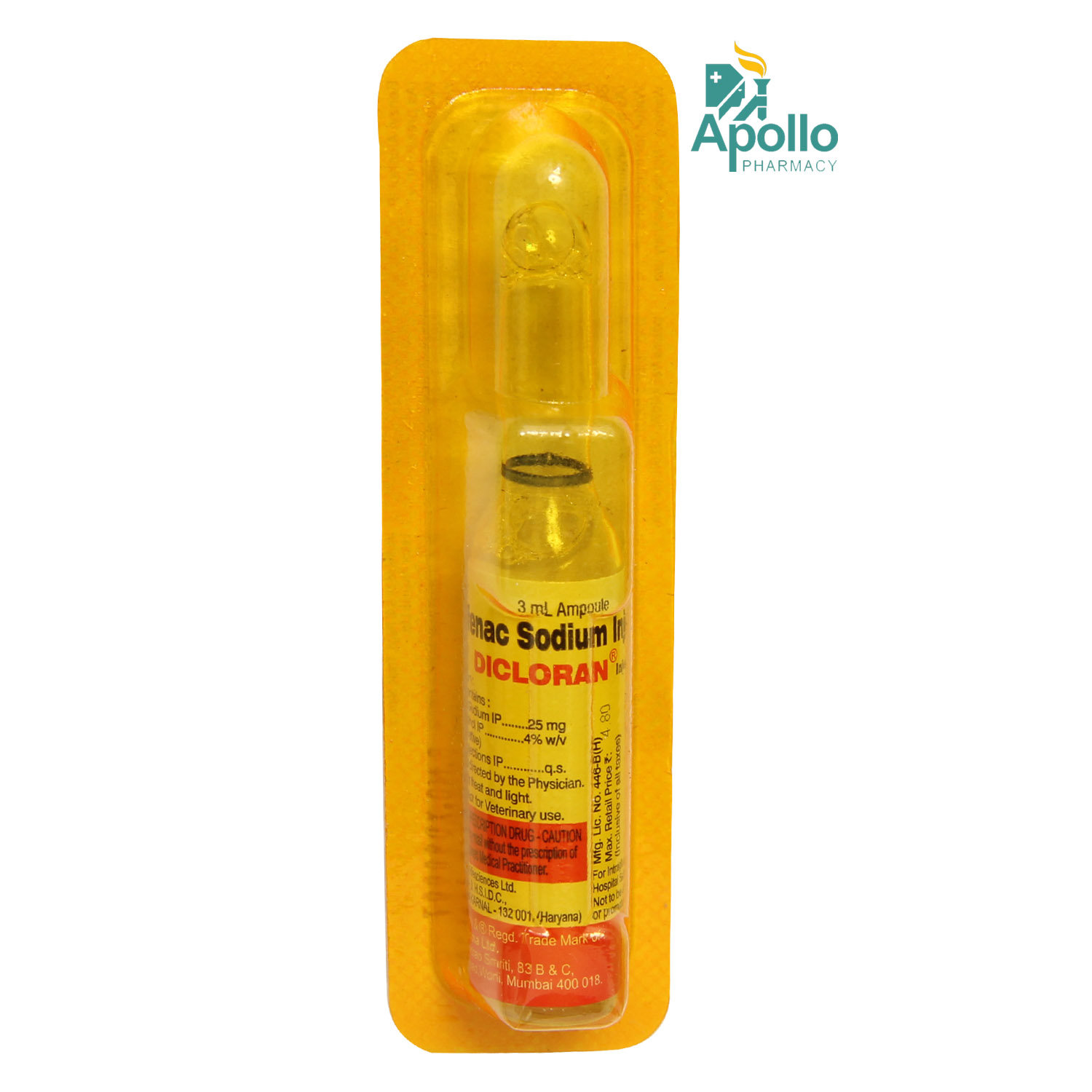Volitra-Aq 1Ml Inj


MRP ₹15
(Inclusive of all Taxes)
₹2.3 Cashback (15%)
Provide Delivery Location
Online payment accepted
 Prescription drug
Prescription drugWhats That
Composition :
Manufacturer/Marketer :
Consume Type :
Return Policy :
Expires on or after :
About Volitra-Aq 1Ml Inj
Volitra-Aq 1Ml Inj belongs to a group of medicines called Non-Steroidal Anti-Inflammatory Drugs (NSAID) used to relieve pain in conditions such as flare-ups of joint and back pain, attacks of gout, pain caused by gall stones, kidney stones, injuries, trauma, fractures and pain following surgery.
Volitra-Aq 1Ml Inj contains ‘Diclofenac’, which works by inhibiting the synthesis of certain chemical messengers which are responsible for causing pain and inflammation. Thereby, Volitra-Aq 1Ml Inj helps provide relief from pain.
Volitra-Aq 1Ml Inj may cause common side effects such as stomach pain, nausea, vomiting, heartburn, and injection site reactions. Most of these side effects do not require medical attention and will resolve gradually over time. However, you are advised to talk to your doctor if the side effects persist or worsen.
Volitra-Aq 1Ml Inj is not recommended during the last three months of pregnancy and for children. Inform your doctor if you are pregnant or breastfeeding before receiving this injection. Keep your doctor informed about your health condition and ongoing medicines to rule out any side effects/interactions.
Uses of Volitra-Aq 1Ml Inj
Directions for Use
Medicinal Benefits
Volitra-Aq 1Ml Inj belongs to a group of medicines called Non-Steroidal Anti-Inflammatory Drugs (NSAID) used to relieve pain in conditions such as flare-ups of joint and back pain, attacks of gout, pain caused by gall stones, kidney stones, injuries, trauma, fractures and pain following surgery. Volitra-Aq 1Ml Inj contains ‘Diclofenac’, which works by inhibiting the synthesis of certain chemical messengers responsible for causing pain and inflammation. Thereby, Volitra-Aq 1Ml Inj helps provide relief from pain.
Storage
- Inform your doctor about the nausea and discuss possible alternatives to the medication or adjustments to the dosage.
- Divide your daily food intake into smaller, more frequent meals to reduce nausea.
- Opt for bland, easily digestible foods like crackers, toast, plain rice, bananas, and applesauce.
- Avoid certain foods that can trigger nausea, such as fatty, greasy, spicy, and smelly foods.
- Drink plenty of fluids, such as water, clear broth, or electrolyte-rich beverages like coconut water or sports drinks.
- Use ginger (tea, ale, or candies) to help relieve nausea.
- Get adequate rest and also avoid strenuous activities that can worsen nausea.
- Talk to your doctor about taking anti-nausea medication if your nausea is severe.
- Record when your nausea occurs, what triggers it, and what provides relief to help you identify patterns and manage your symptoms more effectively.
- Inform your doctor about your constipation symptoms. They may adjust your medication or advise alternative treatments.
- Stay hydrated by drinking sufficient of water (at least 8-10 glasses a day) to help soften stool and promote bowel movements.
- Increase fibre intake by eating foods high in fibre, such as fruits, whole grains, vegetables and legumes, to help bulk up the stool.
- Establish a bowel routine by trying to go to the bathroom at the same time each day to train your bowels.
- Engaging in regular exercise, like walking or yoga, can support in bowel movement stimulation.
- Consult your doctor if constipation persists, and discuss alternative treatments or adjustments to your medication.
- High levels of liver enzymes need immediate medical attention.
- Watch your diet and consume low-fat foods, like green leafy vegetables, fish, whole grains, nuts, etc.
- Regularly do strengthening exercises to control your cholesterol levels.
- Avoid drinking alcohol as it can affect your liver.
- Focus on losing weight as it can help control cholesterol and maintain liver enzymes.
- Practice yoga and meditation to improve liver functioning and overall health.
- Limit processed foods and eat more vegetables and fruits.
- Exercise at least 30 minutes every day.
- Maintain a healthy weight.
- Quit smoking as it can worsen kidney damage.
- Control your blood pressure and blood glucose.
- Limit salt intake and alcohol consumption.
- Report the itching to your doctor immediately; they may need to change your medication or dosage.
- Use a cool, damp cloth on the itchy area to help soothe and calm the skin, reducing itching and inflammation.
- Keep your skin hydrated and healthy with gentle, fragrance-free moisturizers.
- Try not to scratch, as this can worsen the itching and irritate your skin.
- If your doctor prescribes, you can take oral medications or apply topical creams or ointments to help relieve itching.
- Track your itching symptoms and follow your doctor's guidance to adjust your treatment plan if needed. If the itching persists, consult your doctor for further advice.
- Include iron-rich foods like dark leafy vegetables, lean red meat, legumes and fish in your diet.
- Consume vitamin C-rich foods as they aid iron absorption.
- Limit tea, cocoa, and coffee as these can slow iron absorption.
- Exercise regularly; however, do not overdo it.
- Inform your doctor about dizziness symptoms. They may adjust your medication regimen or prescribe additional medications to manage symptoms.
- Follow your doctor's instructions for taking medication, and take it at the same time every day to minimize dizziness.
- When standing up, do so slowly and carefully to avoid sudden dizziness.
- Avoid making sudden movements, such as turning or bending quickly, which can exacerbate dizziness.
- Drink plenty of water throughout the day to stay hydrated and help alleviate dizziness symptoms.
- If you're feeling dizzy, sit or lie down and rest until the dizziness passes.
- Track when dizziness occurs and any factors that may trigger it, and share this information with your doctor to help manage symptoms.
Drug Warnings
Do not take Volitra-Aq 1Ml Inj if you are allergic to any of its components; if you have/had gastric/peptic ulcer, active gastrointestinal bleeding, or coronary artery bypass graft surgery. Inform your doctor if you have/had heart problems, liver or kidney problems, heart attack, stroke, blood circulation problems, bowel disorders, bleeding problems, asthma, porphyria, angina, high blood pressure, high levels of fat, diabetes, or Lupus. Consult your doctor if you are pregnant or breastfeeding. Let your doctor know if you are taking any other medicines or supplements. NSAIDs may increase the risk of cardiovascular events, stroke, myocardial infarction, gastrointestinal bleeding, perforation, and ulceration. Hence, caution should be exercised.
Drug-Drug Interactions
Drug-Drug Interactions
Login/Sign Up
Co-administration of Volitra-Aq 1Ml Inj with Meloxicam can increase the risk or severity of gastrointestinal side effects.
How to manage the interaction:
Taking Meloxicam with Volitra-Aq 1Ml Inj is not recommended as it can possibly result in an interaction, it can be taken if your doctor has advised it. However, consult your doctor immediately if you experience symptoms such as dizziness, lightheadedness, red or black, tarry stools, coughing up or vomiting fresh or dried blood that looks like coffee grounds, severe headache, and weakness. Do not stop any medication without doctor's advise.
Taking Dasatinib together with Volitra-Aq 1Ml Inj may increase the risk of bleeding.
How to manage the interaction:
There may be a possible interaction between Volitra-Aq 1Ml Inj and Dasatinib but they can be taken together if a doctor has prescribed them. However, consult a doctor immediately if you experience dizziness, red or black, tarry stools, or severe headaches. Do not discontinue any medications without consulting a doctor.
Co-administration of Rivaroxaban together with Volitra-Aq 1Ml Inj may increase the risk of unsual bleeding.
How to manage the interaction:
Co-administration of Volitra-Aq 1Ml Inj and Rivaroxaban can lead to an interaction; it can be taken if advised by your doctor. However, if you experience any symptoms like unusual bleeding or bruising, dizziness, lightheadedness, red or black, tarry stools, coughing up or vomiting fresh or dried blood that looks like coffee grounds, severe headache, and weakness, consult your doctor immediately. Do not stop using any medications without a doctor's advice.
Taking Volitra-Aq 1Ml Inj with human immunoglobulin may increase the risk of kidney problems.
How to manage the interaction:
Although there is an interaction between Human immunoglobulin and Volitra-Aq 1Ml Inj, you can take these medicines together if prescribed by a doctor. However, consult the doctor immediately if you experience symptoms such as nausea, vomiting, loss of appetite, increased or decreased urination, sudden weight gain or weight loss, fluid retention, swelling, shortness of breath, muscle cramps, tiredness, weakness, dizziness, confusion, and irregular heart rhythm. Do not discontinue any medications without consulting a doctor.
Taking Volitra-Aq 1Ml Inj and piroxicam can increase the risk of side effects such as ulcers, inflammation (redness, swelling), bleeding.
How to manage the interaction:
Co-administration of Volitra-Aq 1Ml Inj and Piroxicam can lead to an interaction, it can be taken if advised by a doctor. However, if you experience any symptoms like unusual bleeding or bruising, dizziness, lightheadedness, red or black, tarry stools, coughing up or vomiting fresh or dried blood that looks like coffee grounds, severe headache, and weakness, consult a doctor immediately. Do not stop using any medications without a doctor's advice.
Concomitant use of Volitra-Aq 1Ml Inj with dabigatran may increase the risk of stomach bleeding.
How to manage the interaction:
Taking Volitra-Aq 1Ml Inj with dabigatran together possibly results in an interaction, it can be taken if your doctor has advised it. You should consult a doctor immediately if you experience any unusual bleeding or bruising or have other signs and symptoms of bleeding such as dizziness, light headedness, red or black, tarry stools, coughing up or vomiting fresh or dried blood that looks like coffee grounds, severe headache and weakness. Do not stop using any medications without first talking to your doctor.
Taking Volitra-Aq 1Ml Inj with Vorapaxar can increase the risk of bleeding complications.
How to manage the interaction:
There may be a possible interaction between Volitra-Aq 1Ml Inj and Vorapaxar, but they can be taken together if your doctor has prescribed them. However, consult your doctor immediately if you experience any unusual bleeding, dizziness, lightheadedness, red or black, tarry stools, coughing up or vomiting fresh or dried blood that looks like coffee grounds, severe headaches. Do not discontinue any medications without consulting your doctor.
Taking Valdecoxib with Volitra-Aq 1Ml Inj may increase risk of side effects.
How to manage the interaction:
There may be a possible interaction between Volitra-Aq 1Ml Inj and Valdecoxib but can be taken if prescribed by doctor. However, consult your doctor immediately if you experience any unusual bleeding or bruising or have other signs and symptoms of bleeding such as dizziness, lightheadedness, red or black, tarry stools, coughing up or vomiting fresh or dried blood that looks like coffee grounds, severe headache, and weakness. Do not stop any medications without consulting a doctor.
Taking prasugrel together with Volitra-Aq 1Ml Inj may increase the risk of bleeding.
How to manage the interaction:
Co-administration of Volitra-Aq 1Ml Inj and Prasugrel can lead to an interaction; it can be taken if advised by a doctor. However, if you experience any symptoms like unusual bleeding or bruising, dizziness, lightheadedness, red or black, tarry stools, coughing up or vomiting fresh or dried blood that looks like coffee grounds, severe headache, and weakness, consult your doctor immediately. Do not stop using any medications without a doctor's advice.
Co-administration of Volitra-Aq 1Ml Inj with Sirolimus may increase the risk or severity of kidney problems.
How to manage the interaction:
Co-administration of Volitra-Aq 1Ml Inj and Sirolimus can lead to an interaction, but it can be taken if advised by a doctor. However, consult a doctor if you experience any symptoms like nausea, vomiting, loss of appetite, increased or decreased urination, sudden weight gain or weight loss, fluid retention, swelling, shortness of breath, muscle cramps, tiredness, weakness, dizziness, confusion, and irregular heart rhythm. Do not discontinue any medications without consulting a doctor.
Drug-Food Interactions
Drug-Food Interactions
Login/Sign Up
Diet & Lifestyle Advise
- Exercising regularly helps in muscle stretching so that they are less likely to spasm, tear and sprain. Mild exercises such as jogging and walking are helpful for muscle stretching.
- Massages can also be helpful.
- Avoid freezing and hot temperatures.
- Avoid wearing tight-fitting clothes; instead, wear loose garments.
- Rest and sleep well.
- To avoid developing pressure sores, change your position at least every two hours.
- Stay hydrated, and drink plenty of water.
Side Effects of Volitra-Aq 1Ml Inj
- Injection site reactions
- Stomach pain
- Heartburn
- Nausea
- Vomiting
Habit Forming
Therapeutic Class
Product Substitutes
Author Details
We provide you with authentic, trustworthy and relevant information
Drug-Diseases Interactions
Drug-Diseases Interactions
Login/Sign Up
FAQs
Volitra-Aq 1Ml Inj works by inhibiting the synthesis of certain chemical messengers responsible for causing pain and inflammation. Thereby, Volitra-Aq 1Ml Inj helps provide relief from pain.
Concomitant use of Volitra-Aq 1Ml Inj with aspirin is not recommended as it may cause increased gastrointestinal bleeding. Consult your doctor if you have any concerns.
Volitra-Aq 1Ml Inj might make it more difficult to conceive. Therefore, please consult your doctor if you are planning to become pregnant or have problems getting pregnant.
Drug-Drug Interactions Checker List
- WARFARIN
- LITHIUM
- METHOTREXATE
- CICLOSPORIN
- TACROLIMUS
- TRIMETHOPRIM
- MIFEPRISTONE
- VORICONAZOLE
- PHENYTOIN
- CHOLESTYRAMINE
Disease/Condition Glossary
Pain: Pain is a symptom triggered by the nervous system, causing uncomfortable sensations in the body. Pain may be dull or sharp; it might be constant or may come and go. The tolerance level of pain might vary from person to person. Pain can be generalized (overall body aches) or localized (affecting a specific area of the body). The common causes of pain include headache, muscle strain, cramps, fractures, arthritis, and injury.

Have a query?
Buy best C.n.s Drugs products by
Intas Pharmaceuticals Ltd
Sun Pharmaceutical Industries Ltd
Torrent Pharmaceuticals Ltd
Alkem Laboratories Ltd
Abbott India Ltd
Cipla Ltd
Alteus Biogenics Pvt Ltd
Micro Labs Ltd
Lupin Ltd
Ipca Laboratories Ltd
D D Pharmaceuticals Pvt Ltd
Icon Life Sciences
Mankind Pharma Pvt Ltd
Tripada Healthcare Pvt Ltd
Arinna Lifesciences Ltd
Linux Laboratories Pvt Ltd
East West Pharma India Pvt Ltd
La Renon Healthcare Pvt Ltd
Talent India Pvt Ltd
Tas Med India Pvt Ltd
Zydus Healthcare Ltd
Cnx Health Care Pvt Ltd
Eris Life Sciences Ltd
Leeford Healthcare Ltd
Emcure Pharmaceuticals Ltd
Macleods Pharmaceuticals Ltd
Sigmund Promedica
Aristo Pharmaceuticals Pvt Ltd
Dr Reddy's Laboratories Ltd
Troikaa Pharmaceuticals Ltd
Consern Pharma Ltd
Zydus Cadila
Shine Pharmaceuticals Ltd
Wockhardt Ltd
Ardent Life Sciences Pvt Ltd
Crescent Formulations Pvt Ltd
Theo Pharma Pvt Ltd
Reliance Formulation Pvt Ltd
Ikon Pharmaceuticals Pvt Ltd
Propel Healthcare
Neon Laboratories Ltd
Jagsam Pharma
Msn Laboratories Pvt Ltd
Morepen Laboratories Ltd
Pulse Pharmaceuticals
Sanofi India Ltd
Med Manor Organics Pvt Ltd
Hetero Healthcare Pvt Ltd
Novartis India Ltd
Crescent Therapeutics Ltd
Elder Pharmaceuticals Ltd
Solvate Laboratories Pvt Ltd
Akumentis Healthcare Ltd
Mova Pharmaceutical Pvt Ltd
Psyco Remedies Ltd
Tripada Lifecare Pvt Ltd
Ajanta Pharma Ltd
Cyrus Remedies Pvt Ltd
Medishri Healthcare Pvt Ltd
Cadila Healthcare Ltd
Glenmark Pharmaceuticals Ltd
Matteo Health Care Pvt Ltd
Hbc Life Sciences Pvt Ltd
Lyf Healthcare
Matias Healthcare Pvt Ltd
Mesmer Pharmaceuticals
Alembic Pharmaceuticals Ltd
Capital Pharma
Crescent Pharmaceuticals
Medopharm Pvt Ltd
Alniche Life Sciences Pvt Ltd
Kivi Labs Ltd
Talin Remedies Pvt Ltd
USV Pvt Ltd
Quince Lifesciences Pvt Ltd
Solis Pharmaceuticals
Infivis Life Care
Zuventus Healthcare Ltd
Cadila Pharmaceuticals Ltd
Pfizer Ltd
Wallace Pharmaceuticals Pvt Ltd
A N Pharmacia Laboratories Pvt Ltd
Blue Cross Laboratories Pvt Ltd
Jenburkt Pharmaceuticals Ltd
Lia Life Sciences Pvt Ltd
Mano Pharma
Medley Pharmaceuticals Ltd
Primus Remedies Pvt Ltd
FDC Ltd
Maneesh Pharmaceuticals Ltd
Apex Laboratories Pvt Ltd
Gagnant Healthcare Pvt Ltd
Ozone Pharmaceuticals Ltd
RPG Life Sciences Ltd
Strides Shasun Ltd
Unichem International
GlaxoSmithKline Pharmaceuticals Ltd
Kuresys Labs Pvt Ltd
LA Pharma
Trion Pharma India Llp
Alcohol
Consult your doctor
It is not known if alcohol affects Volitra-Aq 1Ml Inj. Please consult your doctor for more information. However, limiting alcohol consumption is recommended while on treatment with Volitra-Aq 1Ml Inj.
Pregnancy
Caution
Volitra-Aq 1Ml Inj is not recommended for use in the last three months of pregnancy as it may harm the unborn child or cause problems at delivery. Hence, if you are pregnant or planning pregnancy, inform your doctor before receiving Volitra-Aq 1Ml Inj. Your doctor may prescribe this medicine if the benefits outweigh the risks.
Breast Feeding
Caution
If you are breastfeeding, inform your doctor before receiving Volitra-Aq 1Ml Inj. Your doctor may prescribe this medicine if the benefits outweigh the risks.
Driving
Caution
Occasionally, Volitra-Aq 1Ml Inj may cause dizziness and tiredness. Drive or operate machinery only if you are alert.
Liver
Consult your doctor
If you have a history of liver disease, inform your doctor before receiving Volitra-Aq 1Ml Inj. Your doctor may adjust the dose of this medicine or prescribe a suitable alternative based on your condition.
Kidney
Caution
If you have a history of kidney diseases, inform your doctor before receiving Volitra-Aq 1Ml Inj. Your doctor may adjust the dose of this medicine or prescribe a suitable alternative based on your condition.
Children
Caution
Volitra-Aq 1Ml Inj is not recommended for children.












_0.jpg?tr=q-85)

